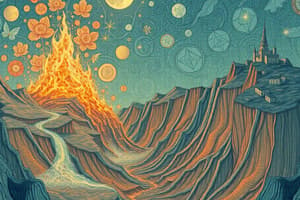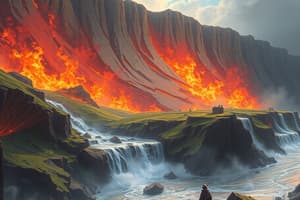Podcast
Questions and Answers
What is the primary cause of earthquakes?
What is the primary cause of earthquakes?
- Changes in ocean currents
- Sudden shifts in the Earth's magnetic field
- Changes in atmospheric pressure
- The release of accumulated strain from tectonic activities (correct)
What is the point on the Earth's surface directly above the hypocenter of an earthquake called?
What is the point on the Earth's surface directly above the hypocenter of an earthquake called?
- Hypocenter
- Seismic wave
- Fault line
- Epicenter (correct)
What is a fault in the context of earthquakes?
What is a fault in the context of earthquakes?
- A plane of fracture in rock bodies where displacement is observable (correct)
- The point where an earthquake originates
- A sudden movement of the Earth's surface
- A type of seismic wave
What is the term used to describe the vibration of the ground during an earthquake?
What is the term used to describe the vibration of the ground during an earthquake?
What is liquefaction in the context of earthquakes?
What is liquefaction in the context of earthquakes?
What is the significance of the hypocenter of an earthquake?
What is the significance of the hypocenter of an earthquake?
What is the most common cause of landslides in the Philippines?
What is the most common cause of landslides in the Philippines?
Which of the following is NOT a primary effect of earthquakes?
Which of the following is NOT a primary effect of earthquakes?
What is ground displacement in the context of earthquakes?
What is ground displacement in the context of earthquakes?
What type of landslide is the most similar to a lahar?
What type of landslide is the most similar to a lahar?
Which of these events is considered a landslide?
Which of these events is considered a landslide?
Which of the following is NOT a contributing factor to landslides?
Which of the following is NOT a contributing factor to landslides?
What is the name of the town that was buried by Mt. Mayon's eruption in 1814?
What is the name of the town that was buried by Mt. Mayon's eruption in 1814?
What is the name of the volcanic hazard composed of a mixture of volcanic debris and water that flows at the slopes of the volcano or with bodies of water?
What is the name of the volcanic hazard composed of a mixture of volcanic debris and water that flows at the slopes of the volcano or with bodies of water?
What was the approximate magnitude of the Luzon earthquake in 1990?
What was the approximate magnitude of the Luzon earthquake in 1990?
What is the main cause of volcanic eruptions?
What is the main cause of volcanic eruptions?
Which of the following is NOT a common effect of tephra falls?
Which of the following is NOT a common effect of tephra falls?
Which volcanic hazard is a mixture of ash, dust, and hot gases that can cause death to living organisms?
Which volcanic hazard is a mixture of ash, dust, and hot gases that can cause death to living organisms?
What is the name of the rock fragments and lava blobs ejected into the air by an erupting volcano?
What is the name of the rock fragments and lava blobs ejected into the air by an erupting volcano?
What is the main difference between lava flows and pyroclastic flows?
What is the main difference between lava flows and pyroclastic flows?
Which event caused the deaths of approximately 800 people in the Philippines in 1991?
Which event caused the deaths of approximately 800 people in the Philippines in 1991?
What is the primary distinction between earthquake magnitude and intensity?
What is the primary distinction between earthquake magnitude and intensity?
What is a potential consequence of liquefaction during an earthquake?
What is a potential consequence of liquefaction during an earthquake?
How are tsunamis triggered?
How are tsunamis triggered?
What is the significance of the PHIVOLCS Earthquake Intensity Scale (PEIS)?
What is the significance of the PHIVOLCS Earthquake Intensity Scale (PEIS)?
What is the primary cause of fires and explosions following an earthquake?
What is the primary cause of fires and explosions following an earthquake?
What is the role of a seismograph in earthquake research?
What is the role of a seismograph in earthquake research?
Based on information provided, which of the following is NOT a direct or indirect consequence of an earthquake?
Based on information provided, which of the following is NOT a direct or indirect consequence of an earthquake?
How does the PEIS differ from the Richter scale?
How does the PEIS differ from the Richter scale?
Flashcards
Geologic Hazards
Geologic Hazards
Naturally occurring processes causing damage and loss of life.
Earthquake
Earthquake
A sudden movement of the earth due to strain release from tectonic activities.
Fault
Fault
A fracture in rock bodies where displacement can be seen.
Hypocenter (Focus)
Hypocenter (Focus)
Signup and view all the flashcards
Epicenter
Epicenter
Signup and view all the flashcards
Ground Shaking
Ground Shaking
Signup and view all the flashcards
Ground Displacement
Ground Displacement
Signup and view all the flashcards
Liquefaction
Liquefaction
Signup and view all the flashcards
Tsunami
Tsunami
Signup and view all the flashcards
Indirect Effects of Earthquake
Indirect Effects of Earthquake
Signup and view all the flashcards
Seismograph
Seismograph
Signup and view all the flashcards
Magnitude
Magnitude
Signup and view all the flashcards
Richter Scale
Richter Scale
Signup and view all the flashcards
Intensity
Intensity
Signup and view all the flashcards
PHIVOLCS Earthquake Intensity Scale
PHIVOLCS Earthquake Intensity Scale
Signup and view all the flashcards
Effects of Fire and Explosions
Effects of Fire and Explosions
Signup and view all the flashcards
Great Luzon Earthquake
Great Luzon Earthquake
Signup and view all the flashcards
Volcanic Eruption
Volcanic Eruption
Signup and view all the flashcards
Lava Flows
Lava Flows
Signup and view all the flashcards
Pyroclastic Flows
Pyroclastic Flows
Signup and view all the flashcards
Tephra Falls
Tephra Falls
Signup and view all the flashcards
Lahar
Lahar
Signup and view all the flashcards
Mt. Pinatubo Eruption
Mt. Pinatubo Eruption
Signup and view all the flashcards
Volcanic Hazards
Volcanic Hazards
Signup and view all the flashcards
Mt. Mayon Eruption
Mt. Mayon Eruption
Signup and view all the flashcards
Landslide
Landslide
Signup and view all the flashcards
Earthflow
Earthflow
Signup and view all the flashcards
Mudflow
Mudflow
Signup and view all the flashcards
Rockfall
Rockfall
Signup and view all the flashcards
Study Notes
Geological Hazards
- Geological hazards are naturally occurring processes that cause significant damage to property and loss of life.
- Examples include earthquakes, volcanic eruptions, and landslides.
Earthquakes
- Earthquakes are sudden movements of the Earth's surface, caused by the release of accumulated strain from tectonic and volcanic activity.
- Earthquakes can damage structures.
Parts of an Earthquake
- Fault: A plane of fracture within rock bodies where observable displacement has occurred. Types include strike-slip, reverse, and normal faults.
- Hypocenter (focus): The exact location of the initial seismic rupture beneath the Earth's surface.
- Epicenter: The point on the Earth's surface directly above the hypocenter.
- Seismic wave: Waves that propagate through the Earth's crust, causing the shaking associated with an earthquake.
Effects of Earthquakes
- Ground shaking: The vibration of the ground during an earthquake, causing partial or total collapse of buildings and structures. Frequency is the number of times ground shaking repeats in a given time. Different frequencies affect structures differently.
- Ground displacement or surface rupture: Horizontal or vertical shifting of the ground surface along fault lines. This seriously damages structures adjacent to faults.
- Liquefaction: The transformation of solid rocks and soil into a liquid-like state during shaking. Large structures may tilt or sink into the liquefied material. Liquefaction requires loose, water-saturated granular sediments alongside strong shaking.
- Tsunamis: Long, high ocean waves caused by earthquakes or disturbances under the sea. These cause flooding and destruction of structures.
- Fire and explosions: Rupture of gas and electrical lines during shaking can lead to explosions, causing death and property destruction.
Intensity and Magnitude of Earthquakes
- Magnitude: The amount of energy released by an earthquake. Measured by seismographs.
- Intensity: A measure of the ground shaking based on damage to properties, and influenced by local geography/geology. The Philippine Intensity Scale is used in the Philippines.
The Richter Scale
- A scale used to measure earthquake magnitude.
- Different ranges of magnitude cause different levels of damage and destruction on human structures and infrastructure..
Philippine Institute of Volcanology and Seismology (PHIVOLCS) Earthquake Intensity Scale (PEIS)
- The PEIS is a scale for measuring earthquake intensity based on damage to properties in the Philippines. Intensity ranges from barely perceptible to practically total destruction of human structures, depending on local ground conditions and infrastructure.
Earthquakes in the Philippines
- The 1990 Luzon earthquake had a magnitude of 7.8, claiming over 2400 lives.
- Other significant earthquakes have also occurred in the Philippines.
Volcanic Hazards
- Events associated with volcanic activity can have adverse effects on organisms and their environment.
Volcanic Eruptions
- The discharge of materials and gases from the volcano's interior to the surface and atmosphere caused by the accumulation of magma in the volcano's chambers and buildup of pressure.
Volcanic Hazards: Lava Flows
- Molten rock (lava) flowing from volcanic openings. Causes damage to structures, killing vegetation, and potentially destroying areas.
Volcanic Hazards: Pyroclastic Flows
- A mixture of hot, dry pyroclastic material—ash, dust, and hot gases (tephra)—flows rapidly down the slopes of a volcano, carrying toxic elements. They are devastating.
Volcanic Hazards: Tephra Falls
- Rock fragments and lava blobs ejected into the air during an eruption. This can damage buildings, power lines, kill vegetation, and cause respiratory problems.
Volcanic Hazards: Lahars
- A mixture of volcanic debris and water flowing like a mudslide down a volcano's slopes. This destroys buildings and infrastructure, and buries towns and crops.
Volcanic Eruptions in the Philippines
- The 1991 eruption of Mount Pinatubo was one of the world's largest eruptions of the 20th century, killing over 800 people.
- Mount Mayon is the most active volcano in the Philippines, with previous eruptions causing devastating damage.
Landslides
-
Events associated with landslide activity cause adverse effects on organisms and their environment.
-
Landslides occur when earth materials (e.g. rocks, debris and soil) move downwards along a slope.
-
Factors that cause landslides include earthquakes, heavy rainfall, deforestation, blasting, and construction activities.
Forms of Landslides
- Earthflow: The downward flow of fine-grained materials (clay, fine sand, silt)
- Mudflows: Fast-moving wet flows of a mixture of water and earth debris; similar to lahars.
- Rockfalls: The movement of unconsolidated rock material downslope due to gravity.
Landslides in the Philippines
- In 2006 and 2003 major landslide events in Southern Leyte killed over 1,000 and 200 people respectively, triggered by heavy rainfall.
Studying That Suits You
Use AI to generate personalized quizzes and flashcards to suit your learning preferences.




